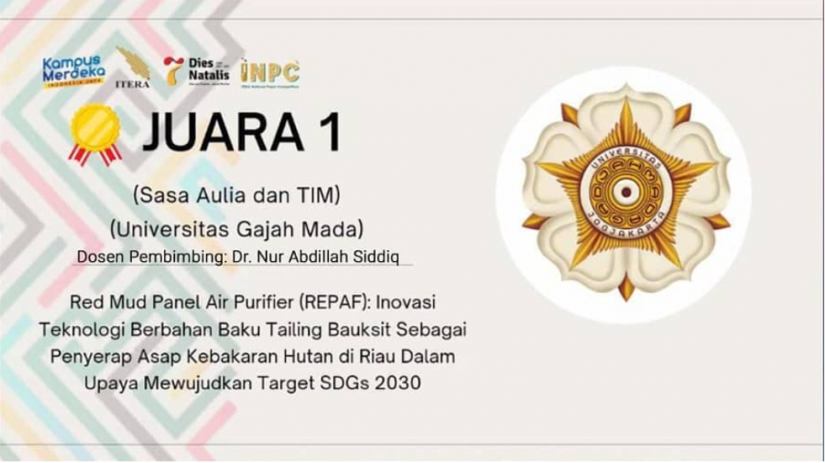
The Institut Teknologi Sumatera (ITERA) held a competition event in June 2021 to celebrate the 7th ITERA Anniversary in the form of a national-scale paper competition , namely the ITERA National Paper Competition (INPC 2021). The theme raised in the paper and poster competition is “Empowering the Potential of Natural Resources in Indonesia, Especially Sumatra”. This competition includes three stages, namely the collection of digests on August 10, 2021, from 194 participants, the team with the best essence is then selected to take part in the full paper collection stage.on September 10, then from the 50 best teams the 10 best teams were selected to take part in the video and presentation stage on October 3, 2021. The 1st place was won by the Universitas Gadjah Mada Team consisting of Sasa Aulia (TF20), Al Ainna Assyifa (TGL20) , and Larasati Aditama (TGL20) with his supervisor Dr. Nur Abdillah Siddiq, ST
In this competition, the proposed paper is entitled “Red Mud Panel Air Purifier (REPAF): Technological Innovation Made from Bauxite Tailings as a Smoke Absorber from Forest Fires in Riau in an Effort to Achieve the 2030 SDGs Target”. The reason behind the making of this paper is the vast area of forest that is being misused by some irresponsible people by opening oil palm plantations and illegal logging.. As a result, there is smog caused by forest fires. Forest fires are one of the main reasons why Indonesia is ranked fourth as the country that contributes the highest carbon emissions in the world. The main problem that is in the government’s spotlight due to forest fires is ARI or Acute Respiratory Infection. In 2019, the Riau Provincial Health Office recorded that 61,017 Riau residents were stricken with ARI due to smoke from forest fires. In addition, Indonesia is famous for its abundant natural resource potential of bauxite. The Central Statistics Agency recorded that there were 16,592,187 tons of bauxite in 2021 and most of it was in the Sumatra region. Through the 2015 Paris Agreement, Indonesia has committed to reduce carbon emissions by 29% by 2030 with its own efforts. Therefore,
The components in REPAF consist of several parts: 1) a place to put the compressed zeolite from the crystallization process, 2) nets, and 3) aluminum poles shaped like billboard panels . In the rectangular zeolite area, bauxite tailings that have been processed into zeolite as adsorbent are placed in the middle with a weight of bauxite tailings as zeolite for one pair of about 12 kg. Then the zeolite is coated with a net that prevents large objects from entering the REPAF system. The REPAF pole frame is made of aluminum frame with a length of 300 cm. Then, the REPAF system has an automatic closing door ( sliding door).) which serves as a cover if it is raining, so it does not affect the condition of the zeolite. This automatic closing door uses a controller stored by local residents, so that when one of the residents presses the control button, REPAF will automatically be closed by a rain barrier in the form of a door. REPAF system is capable of absorbing gas CO 2 by the absorption capacity of 6.4 mmol / g of zeolite, compared with natural raw material zeolite active with the absorption capacity of CO 2 1.165 mmol / g zeolite, REPAF as effective absorption of CO 2 higher. The implementation of the REPAF system has proven to be economically feasible. This is based on the results of economic analysis which shows a Return on Investment around 40% and the profit from the sale can improve the welfare of the community.
“From our submission of this innovation, we hope that it can be a solution for the government in dealing with forest fires in Indonesia, so that we don’t just rely on firefighters and rain that comes from time to time. In addition, our innovations can also help make the SGDs program a success in 2030,” said Sasa.



